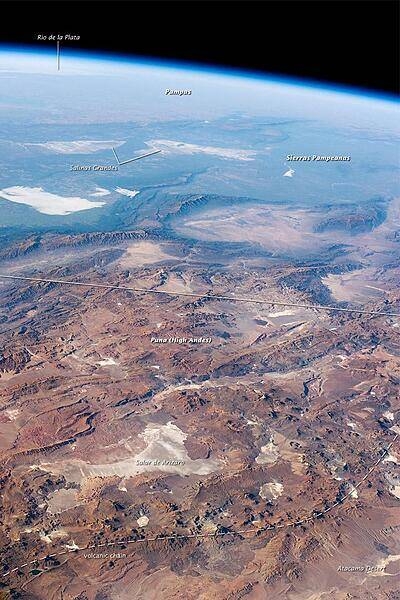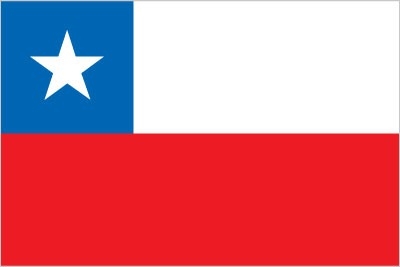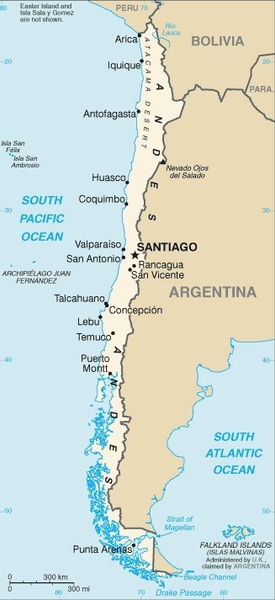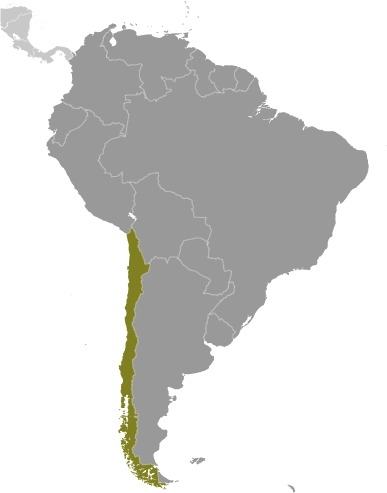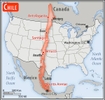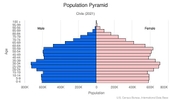Introduction
Background
Prior to the arrival of the Spanish in the 16th century, the Inca ruled northern Chile for nearly a century while an indigenous people, the Mapuche, inhabited central and southern Chile. Although Chile declared its independence in 1810, it did not achieve decisive victory over the Spanish until 1818. In the War of the Pacific (1879-83), Chile defeated Peru and Bolivia to win its present northern regions. In the 1880s, the Chilean central government gained control over the central and southern regions inhabited by the Mapuche. After a series of elected governments, the three-year-old Marxist government of Salvador ALLENDE was overthrown in 1973 by a military coup led by General Augusto PINOCHET, who ruled until a democratically-elected president was inaugurated in 1990. Economic reforms, maintained consistently since the 1980s, contributed to steady growth, reduced poverty rates by over half, and helped secure the country's commitment to democratic and representative government. Chile has increasingly assumed regional and international leadership roles befitting its status as a stable, democratic nation.
Visit the Definitions and Notes page to view a description of each topic.
Geography
Location
Southern South America, bordering the South Pacific Ocean, between Argentina and Peru
Geographic coordinates
30 00 S, 71 00 W
Map references
South America
Area
total: 756,102 sq km
land: 743,812 sq km
water: 12,290 sq km
note: includes Easter Island (Isla de Pascua) and Isla Sala y Gomez
Land boundaries
total: 7,801 km
border countries (3): Argentina 6691 km, Bolivia 942 km, Peru 168 km
Coastline
6,435 km
Maritime claims
territorial sea: 12 nm
contiguous zone: 24 nm
exclusive economic zone: 200 nm
continental shelf: 200/350 nm
Climate
temperate; desert in north; Mediterranean in central region; cool and damp in south
Terrain
low coastal mountains, fertile central valley, rugged Andes in east
Elevation
highest point: Nevado Ojos del Salado 6,893 m (highest volcano in the world)
lowest point: Pacific Ocean 0 m
mean elevation: 1,871 m
Natural resources
copper, timber, iron ore, nitrates, precious metals, molybdenum, hydropower
Land use
agricultural land: 21.1% (2018 est.)
arable land: 1.7% (2018 est.)
permanent crops: 0.6% (2018 est.)
permanent pasture: 18.8% (2018 est.)
forest: 21.9% (2018 est.)
other: 57% (2018 est.)
Irrigated land
11,100 sq km (2012)
Major lakes (area sq km)
Fresh water lake(s): Lago General Carrera (shared with Argentina) - 2,240 sq km; Lago O'Higgins (shared with Argentina) - 1,010 sq km; Lago Llanquihue - 800 sq km; Lago Fagnano (shared with Argentina) - 590 sq km
Population distribution
90% of the population is located in the middle third of the country around the capital of Santiago; the far north (anchored by the Atacama Desert) and the extreme south are relatively underpopulated
Natural hazards
severe earthquakes; active volcanism; tsunamis
volcanism: significant volcanic activity due to more than three-dozen active volcanoes along the Andes Mountains; Lascar (5,592 m), which last erupted in 2007, is the most active volcano in the northern Chilean Andes; Llaima (3,125 m) in central Chile, which last erupted in 2009, is another of the country's most active; Chaiten's 2008 eruption forced major evacuations; other notable historically active volcanoes include Cerro Hudson, Calbuco, Copahue, Guallatiri, Llullaillaco, Nevados de Chillan, Puyehue, San Pedro, and Villarrica; see note 2 under "Geography - note"
Geography - note
note 1: the longest north-south trending country in the world, extending across 39 degrees of latitude; strategic location relative to sea lanes between the Atlantic and Pacific Oceans (Strait of Magellan, Beagle Channel, Drake Passage)
note 2: Chile is one of the countries along the Ring of Fire, a belt of active volcanoes and earthquake epicenters bordering the Pacific Ocean; up to 90% of the world's earthquakes and some 75% of the world's volcanoes occur within the Ring of Fire
note 3: the Atacama Desert - the driest desert in the world - spreads across the northern part of the country; Ojos del Salado (6,893 m) in the Atacama Desert is the highest active volcano in the world, Chile's tallest mountain, and the second highest in the Western Hemisphere and the Southern Hemisphere - its small crater lake (at 6,390 m) is the world's highest lake
People and Society
Nationality
noun: Chilean(s)
adjective: Chilean
Ethnic groups
White and non-Indigenous 88.9%, Mapuche 9.1%, Aymara 0.7%, other Indigenous groups 1% (includes Rapa Nui, Likan Antai, Quechua, Colla, Diaguita, Kawesqar, Yagan or Yamana), unspecified 0.3% (2012 est.)
Languages
Spanish 99.5% (official), English 10.2%, Indigenous 1% (includes Mapudungun, Aymara, Quechua, Rapa Nui), other 2.3%, unspecified 0.2%; note - shares sum to more than 100% because some respondents gave more than one answer on the census (2012 est.)
major-language sample(s):
La Libreta Informativa del Mundo, la fuente indispensable de información básica. (Spanish)
The World Factbook, the indispensable source for basic information.
Religions
Roman Catholic 66.7%, Evangelical or Protestant 16.4%, Jehovah's Witness 1%, other 3.4%, none 11.5%, unspecified 1.1% (2012 est.)
Demographic profile
Chile is in the advanced stages of demographic transition and is becoming an aging society - with fertility below replacement level, low mortality rates, and life expectancy on par with developed countries. Nevertheless, with its dependency ratio nearing its low point, Chile could benefit from its favorable age structure. It will need to keep its large working-age population productively employed, while preparing to provide for the needs of its growing proportion of elderly people, especially as women - the traditional caregivers - increasingly enter the workforce. Over the last two decades, Chile has made great strides in reducing its poverty rate, which is now lower than most Latin American countries. However, its severe income inequality ranks as the worst among members of the Organization for Economic Cooperation and Development. Unequal access to quality education perpetuates this uneven income distribution.
Chile has historically been a country of emigration but has slowly become more attractive to immigrants since transitioning to democracy in 1990 and improving its economic stability (other regional destinations have concurrently experienced deteriorating economic and political conditions). Most of Chile's small but growing foreign-born population consists of transplants from other Latin American countries, especially Peru.
Age structure
0-14 years: 19.79% (male 1,836,240/female 1,763,124)
15-24 years: 13.84% (male 1,283,710/female 1,233,238)
25-54 years: 42.58% (male 3,882,405/female 3,860,700)
55-64 years: 11.98% (male 1,034,049/female 1,145,022)
65 years and over: 11.81% (male 902,392/female 1,245,890) (2020 est.)
Dependency ratios
total dependency ratio: 45.9
youth dependency ratio: 28.1
elderly dependency ratio: 17.9
potential support ratio: 5.6 (2020 est.)
Median age
total: 35.5 years
male: 34.3 years
female: 36.7 years (2020 est.)
Population distribution
90% of the population is located in the middle third of the country around the capital of Santiago; the far north (anchored by the Atacama Desert) and the extreme south are relatively underpopulated
Urbanization
urban population: 87.8% of total population (2021)
rate of urbanization: 0.78% annual rate of change (2020-25 est.)
Major urban areas - population
6.812 million SANTIAGO (capital), 992,000 Valparaiso, 892,000 Concepcion (2021)
Sex ratio
at birth: 1.04 male(s)/female
0-14 years: 1.04 male(s)/female
15-24 years: 1.04 male(s)/female
25-54 years: 1.01 male(s)/female
55-64 years: 0.9 male(s)/female
65 years and over: 0.72 male(s)/female
total population: 0.97 male(s)/female (2020 est.)
Maternal mortality ratio
13 deaths/100,000 live births (2017 est.)
country comparison to the world: 138Infant mortality rate
total: 6.68 deaths/1,000 live births
male: 7.26 deaths/1,000 live births
female: 6.08 deaths/1,000 live births (2021 est.)
Life expectancy at birth
total population: 79.57 years
male: 76.55 years
female: 82.71 years (2021 est.)
Contraceptive prevalence rate
76.3% (2015/16)
Drinking water source
improved: urban: 100% of population
rural: 100% of population
total: 100% of population
unimproved: urban: 0% of population
rural: 0% of population
total: 0% of population (2017 est.)
Current Health Expenditure
9.1% (2018)
Physicians density
2.59 physicians/1,000 population (2018)
Hospital bed density
2.1 beds/1,000 population (2018)
Sanitation facility access
improved: urban: 100% of population
rural: 100% of population
total: 100% of population
unimproved: urban: 0% of population
rural: 0% of population
total: 0% of population (2017 est.)
HIV/AIDS - deaths
<1000 (2018)
Literacy
definition: age 15 and over can read and write
total population: 96.4%
male: 96.3%
female: 96.3% (2017)
School life expectancy (primary to tertiary education)
total: 17 years
male: 17 years
female: 17 years (2019)
Unemployment, youth ages 15-24
total: 24.9%
male: 23.7%
female: 26.6% (2020 est.)
Environment
Environment - current issues
air pollution from industrial and vehicle emissions; water pollution from raw sewage; noise pollution; improper garbage disposal; soil degradation; widespread deforestation and mining threaten the environment; wildlife conservation
Environment - international agreements
party to: Antarctic-Environmental Protection, Antarctic-Marine Living Resources, Antarctic Seals, Antarctic Treaty, Biodiversity, Climate Change, Climate Change-Kyoto Protocol, Climate Change-Paris Agreement, Comprehensive Nuclear Test Ban, Desertification, Endangered Species, Environmental Modification, Hazardous Wastes, Law of the Sea, Marine Dumping-London Convention, Marine Dumping-London Protocol, Nuclear Test Ban, Ozone Layer Protection, Ship Pollution, Wetlands, Whaling
signed, but not ratified: none of the selected agreements
Air pollutants
particulate matter emissions: 21.03 micrograms per cubic meter (2016 est.)
carbon dioxide emissions: 85.82 megatons (2016 est.)
methane emissions: 15.97 megatons (2020 est.)
Climate
temperate; desert in north; Mediterranean in central region; cool and damp in south
Land use
agricultural land: 21.1% (2018 est.)
arable land: 1.7% (2018 est.)
permanent crops: 0.6% (2018 est.)
permanent pasture: 18.8% (2018 est.)
forest: 21.9% (2018 est.)
other: 57% (2018 est.)
Urbanization
urban population: 87.8% of total population (2021)
rate of urbanization: 0.78% annual rate of change (2020-25 est.)
Revenue from forest resources
forest revenues: 0.49% of GDP (2018 est.)
country comparison to the world: 67Waste and recycling
municipal solid waste generated annually: 6.517 million tons (2009 est.)
municipal solid waste recycled annually: 24,113 tons (2009 est.)
percent of municipal solid waste recycled: 0.4% (2009 est.)
Major lakes (area sq km)
Fresh water lake(s): Lago General Carrera (shared with Argentina) - 2,240 sq km; Lago O'Higgins (shared with Argentina) - 1,010 sq km; Lago Llanquihue - 800 sq km; Lago Fagnano (shared with Argentina) - 590 sq km
Total water withdrawal
municipal: 1.267 billion cubic meters (2017 est.)
industrial: 4.744 billion cubic meters (2017 est.)
agricultural: 29.42 billion cubic meters (2017 est.)
Total renewable water resources
923.06 billion cubic meters (2017 est.)
Government
Country name
conventional long form: Republic of Chile
conventional short form: Chile
local long form: Republica de Chile
local short form: Chile
etymology: derivation of the name is unclear, but it may come from the Mapuche word "chilli" meaning "limit of the earth" or from the Quechua "chiri" meaning "cold"
Government type
presidential republic
Capital
name: Santiago; note - Valparaiso is the seat of the national legislature
geographic coordinates: 33 27 S, 70 40 W
time difference: UTC-3 (2 hours ahead of Washington, DC, during Standard Time)
daylight saving time: +1hr, begins second Sunday in August; ends second Sunday in May; note - Punta Arenas observes DST throughout the year
time zone note: Chile has three time zones: the continental portion at UTC-3; the southern Magallanes region, which does not use daylight savings time and remains at UTC-3 for the summer months; and Easter Island at UTC-5
etymology: Santiago is named after the biblical figure Saint James (ca. A.D. 3-44), patron saint of Spain, but especially revered in Galicia; "Santiago" derives from the local Galician evolution of the Vulgar Latin "Sanctu Iacobu"; Valparaiso derives from the Spanish "Valle Paraiso" meaning "Paradise Valley"
Administrative divisions
16 regions (regiones, singular - region); Aysen, Antofagasta, Araucania, Arica y Parinacota, Atacama, Biobio, Coquimbo, Libertador General Bernardo O'Higgins, Los Lagos, Los Rios, Magallanes y de la Antartica Chilena (Magallanes and Chilean Antarctica), Maule, Nuble, Region Metropolitana (Santiago), Tarapaca, Valparaiso
note: the US does not recognize any claims to Antarctica
Independence
18 September 1810 (from Spain)
National holiday
Independence Day, 18 September (1810)
Constitution
history: many previous; latest adopted 11 September 1980, effective 11 March 1981; a referendum held on 25 October 2020 approved forming a convention to draft a new constitution, and on 15-16 May 2021, a referendum was held to elect members to the convention
amendments: proposed by members of either house of the National Congress or by the president of the republic; passage requires at least three-fifths majority vote of the membership in both houses and approval by the president; passage of amendments to constitutional articles, such as the republican form of government, basic rights and freedoms, the Constitutional Tribunal, electoral justice, the Council of National Security, or the constitutional amendment process, requires at least two-third majority vote by both houses of Congress and approval by the president; the president can opt to hold a referendum when Congress and the president disagree on an amendment; amended many times, last in 2020
Legal system
civil law system influenced by several West European civil legal systems; judicial review of legislative acts by the Constitutional Tribunal
International law organization participation
has not submitted an ICJ jurisdiction declaration; accepts ICCt jurisdiction
Citizenship
citizenship by birth: yes
citizenship by descent only: yes
dual citizenship recognized: yes
residency requirement for naturalization: 5 years
Suffrage
18 years of age; universal
Executive branch
chief of state: President Sebastian PINERA Echenique (since 11 March 2018); note - the president is both chief of state and head of government
head of government: President Sebastian PINERA Echenique (since 11 March 2018)
cabinet: Cabinet appointed by the president
elections/appointments: president directly elected by absolute majority popular vote in 2 rounds if needed for a single 4-year term; election last held on 21 November 2021 with a runoff held on 19 December 2021 (next to be held on 23 November 2025 with runoff if need on 20 December)
election results:
2021: Gabriel BORIC elected president in second round; percent of vote in first round - Jose Antonio KAST (FSC) 27.9%; Gabriel BORIC (AD) 25.8%; Franco PARISI (PDG) 12.8%; Sebastian SICHEL (ChP+) 12.8%; Yasna PROVOSTE (New Social Pact) 11.6%; other 9.1%; percent of vote in second round - Gabriel BORIC (AD) 55.9%; Jose Antonio KAST (FSC) 44.1%; note - BORIC will take office 11 March 2022
2017: Sebastian PINERA Echenique elected president in second round; percent of vote in first round - Sebastian PINERA Echenique (independent) 36.6%; Alejandro GUILLIER (independent) 22.7%; Beatriz SANCHEZ (independent) 20.3%; Jose Antonio KAST (independent) 7.9%; Carolina GOIC (PDC) 5.9%; Marco ENRIQUEZ-OMINAMI (PRO) 5.7%; other 0.9%; percent of vote in second round - Sebastian PINERA Echenique 54.6%, Alejandro GUILLIER 45.4%
Legislative branch
description: bicameral National Congress or Congreso Nacional consists of:
Senate or Senado (50 seats); members directly elected in multi-seat constituencies by open party-list proportional representation vote to serve 8-year terms with one-half of the membership renewed every 4 years)
Chamber of Deputies or Camara de Diputados (155 seats; members directly elected in multi-seat constituencies by open party-list proportional representation vote to serve 4-year terms)
elections:
Senate - last held on 21 November 2021 (next to be held on 23 November 2025)
Chamber of Deputies - last held on 21 November 2021 (next to be held on 23 November 2025)
election results:
Senate - percent of vote by party - NA; seats by party - ChP+ 12 (RN 5, UDI 5, EVOPOLI 2), NPS 8 (PS 4, PPD 2, PDC 2), PLR 1, AD 4 (PCCh 2, FREVS 2) independent 2; compostion - men 36, women 14, percent of women 27.9%
Chamber of Deputies - percent of vote by party - NA; seats by party - ChP+ 53 (RN 25, UDI 23, EVOPOLI 4, PRI 1), AD 37 (PCCh 12, CS 9, RD 8, Commons 6, FREVS 2), NPS 37 (PS 13, PDC 8, PPD 7, PL 4, PRSD 4, CIU 1), FSC 15 (PLR 14, PCC 1), PDG 6, DA 3, PEV 2, IU 1, independent 1; composition - men 100, women 55, percent of women 35.5%; note - overall National Congress percent of women 33.7%
Judicial branch
highest courts: Supreme Court or Corte Suprema (consists of a court president and 20 members or ministros); Constitutional Court (consists of 10 members); Elections Qualifying Court (consists of 5 members)
judge selection and term of office: Supreme Court president and judges (ministers) appointed by the president of the republic and ratified by the Senate from lists of candidates provided by the court itself; judges appointed for life with mandatory retirement at age 70; Constitutional Court members appointed - 3 by the Supreme Court, 3 by the president of the republic, 2 by the Chamber of Deputies, and 2 by the Senate; members serve 9-year terms with partial membership replacement every 3 years (the court reviews constitutionality of legislation); Elections Qualifying Court members appointed by lottery - 1 by the former president or vice president of the Senate and 1 by the former president or vice president of the Chamber of Deputies, 2 by the Supreme Court, and 1 by the Appellate Court of Valparaiso; members appointed for 4-year terms
subordinate courts: Courts of Appeal; oral criminal tribunals; military tribunals; local police courts; specialized tribunals and courts in matters such as family, labor, customs, taxes, and electoral affairs
Political parties and leaders
Approve Dignity or AD [Gabriel BORIC]
Broad Front Coalition (Frente Amplio) or FA (includes RD, PL, PH, PEV, Igualdad, and Poder) [Beatriz SANCHEZ]
Broad Social Movement of Leftist Citizens (includes former MAS and Izquierda Ciudadana) [Fernando ZAMORANO]
Chile We Can Do More or ChP+ [Sebastian SICHEL] (includes EVOPOLI, PRI, RN, UDI)
Christian Conservative Party or PCC [Antaris VARELA]
Christian Democratic Party or PDC [Yasna PROVOSTE]
Christian Social Front or FSC [Jose Antonio KAST] (includes PCC, PLR)
Citizen Power (Poder) [Karina OLIVA]
Citizens or CIU [María Ignacia GOMEZ Martinez]
Commons (Comunes) [Javiera TORO]
Communist Party of Chile or PCCh [Guillermo TEILLIER del Valle]
Democratic Revolution or RD [Rodrigo ECHECOPAR]
Dignity Now or DA [Pamela JILES Moreno and Guillermo GONZALEZ Castro]
Equality Party (Igualdad) [Guillermo GONZALEZ Castro]
Green Ecological Party or PEV [Felix GONZALEZ]
Humanist Party or PH [Octavio GONZALEZ]
Independent Democratic Union or UDI [Javier MACAYA]
Independent Regionalist Democratic Party or PRI [Hugo ORTIZ de Filippi]
Liberal Party (Partido Liberal de Chile) or PL [Luis Felipe RAMOS]
National Renewal or RN [Mario DESBORDES]
New Social Pact or NPS [Yasna PROVOSTE] (includes PDC, PL, PPD, PRSD, PS)
Party for Democracy or PPD [Heraldo MUNOZ]
Party of the People or PDG [Franco PARISI]
Political Evolution or EVOPOLI [Hernan LARRAIN MATTE]
Progressive Party or PRO [Marco Antonio ENRIQUEZ-OMINAMI Gumucio]
Radical Social Democratic Party or PRSD [Carlos MALDONADO Curti]
Republican Party or PLR [Jose Antonio KAST]
Social Convergence or CS [Gabriel BORIC]
Social Green Regionalist Federation or FREVS [Jaime Francisco MULET Martínez]
Socialist Party or PS [Alvaro Antonio ELIZALDE Soto]
United Independents or IU [Cristian Alejandro CONTRERAS Radovic]
International organization participation
APEC, BIS, CAN (associate), CD, CELAC, FAO, G-15, G-77, IADB, IAEA, IBRD, ICAO, ICC (national committees), ICCt, ICRM, IDA, IFAD, IFC, IFRCS, IHO, ILO, IMF, IMO, IMSO, Interpol, IOC, IOM, IPU, ISO, ITSO, ITU, ITUC (NGOs), LAES, LAIA, Mercosur (associate), MIGA, MINUSTAH, NAM, OAS, OECD (enhanced engagement), OPANAL, OPCW, Pacific Alliance, PCA, SICA (observer), UN, UNASUR, UNCTAD, UNESCO, UNFICYP, UNHCR, UNIDO, Union Latina, UNMOGIP, UNTSO, UNWTO, UPU, WCO, WFTU (NGOs), WHO, WIPO, WMO, WTO
Diplomatic representation in the US
chief of mission: Ambassador Oscar Alfonso Sebastian SILVA Navarro (since 17 September 2018)
chancery: 1732 Massachusetts Avenue NW, Washington, DC 20036
telephone: [1] (202) 785-1746
FAX: [1] (202) 887-5579
email address and website:
echile.eeuu@minrel.gob.cl
https://chile.gob.cl/estados-unidos/en/
consulate(s) general: Chicago, Houston, Los Angeles, Miami, New York, San Francisco
Diplomatic representation from the US
chief of mission: Ambassador (vacant); Charge d'Affaires Richard H. GLENN (since August 2020)
embassy: Avenida Andres Bello 2800, Las Condes, Santiago
mailing address: 3460 Santiago Place, Washington DC 20521-3460
telephone: [56] (2) 2330-3000
FAX: [56] (2) 2330-3710
email address and website:
SantiagoUSA@state.gov
https://cl.usembassy.gov/
Flag description
two equal horizontal bands of white (top) and red; a blue square the same height as the white band at the hoist-side end of the white band; the square bears a white five-pointed star in the center representing a guide to progress and honor; blue symbolizes the sky, white is for the snow-covered Andes, and red represents the blood spilled to achieve independence
note: design influenced by the US flag
National symbol(s)
huemul (mountain deer), Andean condor; national colors: red, white, blue
National anthem
name: "Himno Nacional de Chile" (National Anthem of Chile)
lyrics/music: Eusebio LILLO Robles and Bernardo DE VERA y Pintado/Ramon CARNICER y Battle
note: music adopted 1828, original lyrics adopted 1818, adapted lyrics adopted 1847; under Augusto PINOCHET's military rule, a verse glorifying the army was added; however, as a protest, some citizens refused to sing this verse; it was removed when democracy was restored in 1990
Economy
Economic overview
Chile has a market-oriented economy characterized by a high level of foreign trade and a reputation for strong financial institutions and sound policy that have given it the strongest sovereign bond rating in South America. Exports of goods and services account for approximately one-third of GDP, with commodities making up some 60% of total exports. Copper is Chile’s top export and provides 20% of government revenue.
From 2003 through 2013, real growth averaged almost 5% per year, despite a slight contraction in 2009 that resulted from the global financial crisis. Growth slowed to an estimated 1.4% in 2017. A continued drop in copper prices prompted Chile to experience its third consecutive year of slow growth.
Chile deepened its longstanding commitment to trade liberalization with the signing of a free trade agreement with the US, effective 1 January 2004. Chile has 26 trade agreements covering 60 countries including agreements with the EU, Mercosur, China, India, South Korea, and Mexico. In May 2010, Chile signed the OECD Convention, becoming the first South American country to join the OECD. In October 2015, Chile signed the Trans-Pacific Partnership trade agreement, which was finalized as the Comprehensive and Progressive Trans-Pacific Partnership (CPTPP) and signed at a ceremony in Chile in March 2018.
The Chilean Government has generally followed a countercyclical fiscal policy, under which it accumulates surpluses in sovereign wealth funds during periods of high copper prices and economic growth, and generally allows deficit spending only during periods of low copper prices and growth. As of 31 October 2016, those sovereign wealth funds - kept mostly outside the country and separate from Central Bank reserves - amounted to more than $23.5 billion. Chile used these funds to finance fiscal stimulus packages during the 2009 economic downturn.
In 2014, then-President Michelle BACHELET introduced tax reforms aimed at delivering her campaign promise to fight inequality and to provide access to education and health care. The reforms are expected to generate additional tax revenues equal to 3% of Chile’s GDP, mostly by increasing corporate tax rates to OECD averages.
Real GDP (purchasing power parity)
$445.88 billion note: data are in 2017 dollars (2020 est.)
$473.19 billion note: data are in 2017 dollars (2019 est.)
$468.77 billion note: data are in 2017 dollars (2018 est.)
note: data are in 2010 dollars
Real GDP growth rate
1.03% (2019 est.)
4% (2018 est.)
1.41% (2017 est.)
Real GDP per capita
$23,300 note: data are in 2017 dollars (2020 est.)
$25,000 note: data are in 2017 dollars (2019 est.)
$25,000 note: data are in 2017 dollars (2018 est.)
note: data are in 2010 dollars
GDP (official exchange rate)
$282.655 billion (2019 est.)
Inflation rate (consumer prices)
2.2% (2019 est.)
2.7% (2018 est.)
2.1% (2017 est.)
Credit ratings
Fitch rating: A- (2020)
Moody's rating: A1 (2018)
Standard & Poors rating: A+ (2017)
GDP - composition, by sector of origin
agriculture: 4.2% (2017 est.)
industry: 32.8% (2017 est.)
services: 63% (2017 est.)
GDP - composition, by end use
household consumption: 62.3% (2017 est.)
government consumption: 14% (2017 est.)
investment in fixed capital: 21.5% (2017 est.)
investment in inventories: 0.5% (2017 est.)
exports of goods and services: 28.7% (2017 est.)
imports of goods and services: -27% (2017 est.)
Agricultural products
grapes, apples, wheat, sugar beet, milk, potatoes, tomatoes, maize, poultry, pork
Industries
copper, lithium, other minerals, foodstuffs, fish processing, iron and steel, wood and wood products, transport equipment, cement, textiles
Labor force - by occupation
agriculture: 9.2%
industry: 23.7%
services: 67.1% (2013)
Population below poverty line
8.6% (2017 est.)
Gini Index coefficient - distribution of family income
44.4 (2017 est.)
57.1 (2000)
Household income or consumption by percentage share
lowest 10%: 1.7%
highest 10%: 41.5% (2013 est.)
Budget
revenues: 57.75 billion (2017 est.)
expenditures: 65.38 billion (2017 est.)
Fiscal year
calendar year
Current account balance
-$10.933 billion (2019 est.)
-$10.601 billion (2018 est.)
Exports
$79.8 billion note: data are in current year dollars (2020 est.)
$78.02 billion note: data are in current year dollars (2019 est.)
$84.65 billion note: data are in current year dollars (2018 est.)
Exports - partners
China 32%, United States 14%, Japan 9%, South Korea 7% (2019)
Exports - commodities
copper, wood pulp, fish fillets, pitted fruits, wine (2019)
Imports
$66.43 billion note: data are in current year dollars (2020 est.)
$80.17 billion note: data are in current year dollars (2019 est.)
$85.11 billion note: data are in current year dollars (2018 est.)
Imports - partners
China 24%, United States 20%, Brazil 8%, Germany 5%, Argentina 5% (2019)
Imports - commodities
refined petroleum, crude petroleum, cars, broadcasting equipment, delivery trucks (2019)
Reserves of foreign exchange and gold
$38.98 billion (31 December 2017 est.)
$40.49 billion (31 December 2016 est.)
Debt - external
$193.298 billion (2019 est.)
$181.089 billion (2018 est.)
Exchange rates
Chilean pesos (CLP) per US dollar -
738.81 (2020 est.)
770.705 (2019 est.)
674.25 (2018 est.)
658.93 (2014 est.)
570.37 (2013 est.)
Unemployment, youth ages 15-24
total: 24.9%
male: 23.7%
female: 26.6% (2020 est.)
Energy
Electricity access
electrification - total population: 100% (2020)
Electricity - installed generating capacity
24.53 million kW (2016 est.)
country comparison to the world: 37Electricity - from fossil fuels
59% of total installed capacity (2016 est.)
country comparison to the world: 133Electricity - from nuclear fuels
0% of total installed capacity (2017 est.)
country comparison to the world: 66Electricity - from hydroelectric plants
26% of total installed capacity (2017 est.)
country comparison to the world: 75Electricity - from other renewable sources
15% of total installed capacity (2017 est.)
country comparison to the world: 56Refined petroleum products - production
216,200 bbl/day (2017 est.)
country comparison to the world: 49Refined petroleum products - consumption
354,500 bbl/day (2017 est.)
country comparison to the world: 39Natural gas - proved reserves
97.97 billion cu m (1 January 2018 est.)
country comparison to the world: 52Communications
Telephones - fixed lines
total subscriptions: 2,567,938 (2020)
subscriptions per 100 inhabitants: 13.43 (2020 est.)
Telephones - mobile cellular
total subscriptions: 25,068,249 (2020)
subscriptions per 100 inhabitants: 131.1 (2020 est.)
Telecommunication systems
general assessment: Chile’s telecom systems are highly competitive and rapidly evolving; mobile penetration rate is among the highest in South America; deployment of 5G networks expected; fixed broadband penetration is high for region, with fast and inexpensive services; government initiatives provide high-capacity connectivity across the country and increase fixed-line broadband penetration; progress with national satellite system; schools received free broadband as part of the ‘Connectivity for Education 2030’ program; submarine cable project to link Chile with New Zealand and Australia; importer of broadcasting equipment from USA (2020)
domestic: number of fixed-line connections have stagnated to 15 per 100 in recent years as mobile-cellular usage continues to increase, reaching 132 telephones per 100 persons; domestic satellite system with 3 earth stations (2019)
international: country code - 56; landing points for the Pan-Am, Prat, SAm-1, American Movil-Telxius West Coast Cable, FOS Quellon-Chacabuco, Fibra Optical Austral, SAC and Curie submarine cables providing links to the US, Caribbean and to Central and South America; satellite earth stations - 2 Intelsat (Atlantic Ocean) (2019)
note: the COVID-19 pandemic continues to have a significant impact on production and supply chains globally; since 2020, some aspects of the telecom sector have experienced downturn, particularly in mobile device production; many network operators delayed upgrades to infrastructure; progress towards 5G implementation was postponed or slowed in some countries; consumer spending on telecom services and devices was affected by large-scale job losses and the consequent restriction on disposable incomes; the crucial nature of telecom services as a tool for work and school from home became evident, and received some support from governments
Broadcast media
national and local terrestrial TV channels, coupled with extensive cable TV networks; the state-owned Television Nacional de Chile (TVN) network is self-financed through commercial advertising revenues and is not under direct government control; large number of privately owned TV stations; about 250 radio stations
Internet users
total: 15.78 million (2021 est.)
percent of population: 82.33% (2019 est.)
Broadband - fixed subscriptions
total: 3,751,227 (2020)
subscriptions per 100 inhabitants: 19.62 (2020 est.)
Transportation
National air transport system
number of registered air carriers: 9 (2020)
inventory of registered aircraft operated by air carriers: 173
annual passenger traffic on registered air carriers: 19,517,185 (2018)
annual freight traffic on registered air carriers: 1,226,440,000 mt-km (2018)
Airports - with paved runways
total: 90
over 3,047 m: 5
2,438 to 3,047 m: 7
1,524 to 2,437 m: 23
914 to 1,523 m: 31
under 914 m: 24 (2017)
Airports - with unpaved runways
total: 391
2,438 to 3,047 m: 5
1,524 to 2,437 m: 11
914 to 1,523 m: 56
under 914 m: 319 (2013)
Heliports
1 (2013)
Pipelines
3160 km gas, 781 km liquid petroleum gas, 985 km oil, 722 km refined products (2013)
Railways
total: 7,282 km (2014)
narrow gauge: 3,853.5 km 1.000-m gauge (2014)
broad gauge: 3,428 km 1.676-m gauge (1,691 km electrified) (2014)
Merchant marine
total: 231
by type: bulk carrier 6, container ship 5, general cargo 58, oil tanker 14, other 148 (2021)
Ports and terminals
major seaport(s): Coronel, Huasco, Lirquen, Puerto Ventanas, San Antonio, San Vicente, Valparaiso
container port(s) (TEUs): San Antonio (1,709,635), Valparaiso (898,715) (2019)
LNG terminal(s) (import): Mejillones, Quintero
Military and Security
Military and security forces
Armed Forces of Chile (Fuerzas Armadas de Chile): Chilean Army (Ejército de Chile), Chilean Navy (Armada de Chile, includes marine units and coast guard or Maritime Territory and Merchant Marine Directorate (Directemar)), Chilean Air Force (Fuerza Aerea de Chile, FACh); Ministry of the Interior and Public Security: Carabineros de Chile (National Police Force) (2021)
note - Carabineros de Chile are responsible to both the Ministry of Defense and the Ministry of the Interior
Military expenditures
2% of GDP (2020 est.)
1.8% of GDP (2019)
1.9% of GDP (2018)
2% of GDP (2017)
2% of GDP (2016)
Military and security service personnel strengths
the Armed Forces of Chile have approximately 80,000 active personnel (45,000 Army; 20,000 Navy; 15,000 Air Force); approximately 50,000 Carabineros (2021)
Military equipment inventories and acquisitions
the Chilean military inventory is comprised of a wide mix of mostly Western equipment and some domestically-produced systems; since 2010, it has received military hardware from nearly 15 countries, including Australia, France, Germany, the Netherlands, and the US; Chile's defense industry has capabilities in military aircraft, ships, and vehicles (2021)
Military service age and obligation
18-45 years of age for voluntary male and female military service, although the right to compulsory recruitment of males 18-45 is retained; service obligation is 12 months for Army and 22 months for Navy and Air Force (2021)
Military - note
the Chilean Army was founded in 1810, but traces its origins back to the Army of the Kingdom of Chile, which was established by the Spanish Crown in the early 1600s; the Navy traces its origins to 1817; it was first led by a British officer and its first ships were largely crewed by American, British, and Irish sailors; by the 1880s, the Chilean Navy was one of the most powerful in the Americas, and included the world’s first protected cruiser (a ship with an armored deck to protect vital machine spaces); Chile's military aviation was inaugurated in 1913 with the creation of a military aviation school
Transnational Issues
Disputes - international
Chile and Peru rebuff Bolivia's reactivated claim to restore the Atacama corridor, ceded to Chile in 1884, but Chile has offered instead unrestricted but not sovereign maritime access through Chile to Bolivian natural gas; Chile rejects Peru's unilateral legislation to change its latitudinal maritime boundary with Chile to an equidistance line with a southwestern axis favoring Peru; in October 2007, Peru took its maritime complaint with Chile to the ICJ; territorial claim in Antarctica (Chilean Antarctic Territory) partially overlaps Argentine and British claims; the joint boundary commission, established by Chile and Argentina in 2001, has yet to map and demarcate the delimited boundary in the inhospitable Andean Southern Ice Field (Campo de Hielo Sur)
Refugees and internally displaced persons
refugees (country of origin): 448,138 (Venezuela) (economic and political crisis; includes Venezuelans who have claimed asylum or have received alternative legal stay) (2020)
Illicit drugs
transshipment country for cocaine destined for Europe and the region; some money laundering activity, especially through the Iquique Free Trade Zone; imported precursors passed on to Bolivia; domestic cocaine consumption is rising, making Chile a significant consumer of cocaine
